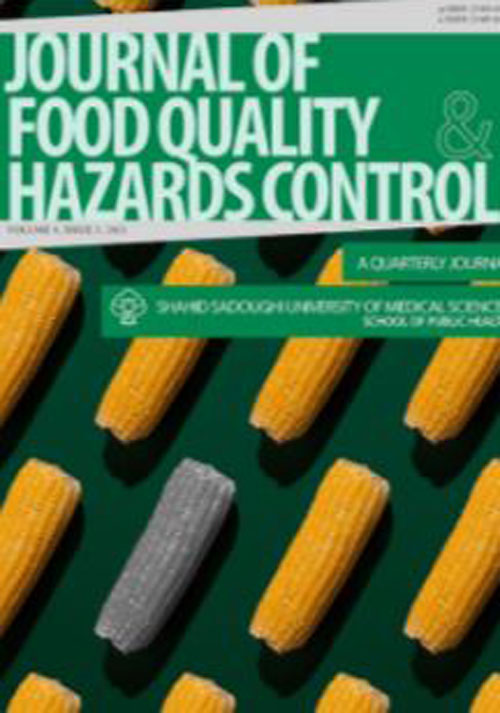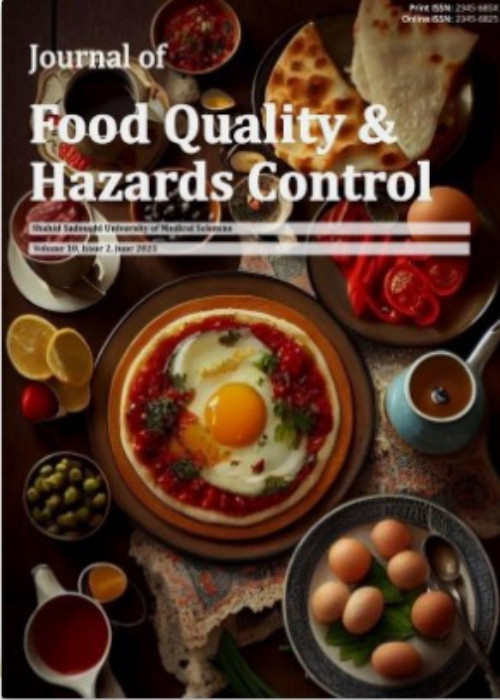فهرست مطالب

Journal of Food Quality and Hazards Control
Volume:8 Issue: 4, Dec 2021
- تاریخ انتشار: 1400/10/18
- تعداد عناوین: 8
-
-
Pages 141-151Background
Table olives are nutritionally a complete food and considered as one of the oldest fermented products. This study aimed to evaluate the effect of Lactiplantibacillus plantarum 11 as a starter culture on the fermentation of table olives at two incubation temperatures 22 and 30 °C and different salt concentrations (0, 4, 8, and 12% m/v) of sodium chloride (NaCl).
MethodsThe fermentation of table olives was carried out according to the Spanish style. L. plantarum 11 was inoculated as a starter culture (106 Colony Forming Unit (CFU)/ml), and Listeria monocytogenes CECT 4032 was used as an indicator strain. Under the same experimental conditions, the fermentation of olives without the inoculation of starter culture was used as a control. Then, biochemical and microbiological quality of each experimental batch was tested.
ResultsUnlike the incubation temperature of 22 °C, the pH values obtained in salted batches and incubated at 30 °C were all below the marketing limits for table olives. At the end of the process, the maximum load of yeasts and molds (>5 log CFU/ml) was recorded in the batches incubated at 22 °C. At 22 °C, Listeria was absent in inoculated fermenters at a concentration greater than or equal to 8% (w/v) of NaCl. However, at 30 °C, Listeria was not detected in treatment groups and in the control group with 12% NaCl.
ConclusionL. plantarum 11 could be potentially considered as a probiotic starter culture during the fermentation of black table olives.
Keywords: Brine, Sodium Chloride, Fermentation, Bacteria, Probiotics, Olea -
Pages 152-161Background
Species identification in commercially processed food and feed products is one of the important issues. This study was conducted to develop a genetic method for the detection of pig and cattle species in processed food and feed products using newly designed species-specific primers targeting mitochondrial 12S rRNA gene fragments.
MethodsTwo sets of specific primers were designed based on the 12S rRNA gene sequences of pig and cattle species from GenBank. The primers were validated by using the DNA extracted from nine different chordates, including pig, cattle, chicken, bata fish, bat, toad, African parrot, rat, and human origin. Annealing temperature ranging from 46-54 °C for 30 s and template DNA 1:10 serial dilutions ranging from 10 to 0.00001 ng/µl were employed for primer annealing and sensitivity analysis. Samples were analyzed using optimized Polymerase Chain Reaction (PCR) conditions.
ResultsThe most intense expected DNA bands of pig and cattle were produced at 50 °C. Under that optimized annealing temperature pig and cattle-specific primers did not anneal with the DNA of other chordates. Total extracted DNA 0.001 ng and 0.01 ng of pig and cattle respectively containing the mitochondrial DNA (mtDNA) was successfully detected.
ConclusionThese findings indicate that the newly designed primer pairs can be used to detect pig and cattle derivatives in various processed food and feed products.
Keywords: Fraud, Food Analysis, DNA, Mitochondrial, DNA Primers, Swine, Cattle -
Pages 162-168Background
The health benefits of probiotic bacteria are not unknown to anyone. On the other hand, indigenous dairy sources are a potential source of native probiotics. This study aimed to describe the inhibitory activity of Cell-Free Supernatant (CFS), planktonic cells, and biofilm form of Lactobacillus strains isolated from native dairy sources on food pathogens.
MethodsAntibacterial activities of the CFS of lactobacillus strains were assessed by the microplate method and via violet staining, and in planktonic cells, and biofilm forms were performed by the spread plate method.
ResultsThe results showed that despite the large differences in biofilm formation power among the strains, most of them can produce biofilm. Lactobacillus delbrueckii subsp. bulgaricus, Lactobacillus plantarum, L. delbrueckii subsp. Lactis, Lactobacillus brevis, and Lactobacillus lactis subsp. lactis formed the strongest biofilm, respectively. Planktonic states reduce the pathogens bacterial by about 1.43 log, but in biofilm forms, decreased Listeria monocytogenes by about 4.8 log compared to the control, and in the case of Pseudomonas aeruginosa, a growth reduction of about 2.8 logs was observed.
ConclusionAccording to the study, biofilm produced by probiotic strains can be considered a new approach for biological control. Also, indigenous dairy sources can be considered by researchers to extract natural and beneficial probiotics.
Keywords: Biofilms, Lactobacillales, Lactobacillus, Probiotics, Anti-Infective Agents, Dairy Products -
Pages 169-177Background
Pekmez is an important fruit-based food of Turkish culinary culture. The aim of this study is to determine the levels of acrylamide (AA), 5-hydroxymethyl-2-furfural (HMF) and other selected parameters in grape, mulberry and carob Pekmez.
MethodsAA and HMF were analyzed by Liquid Chromatography and High Performance Liquid Chromatography, respectively. Also, glucose, fructose, pH, protein, total phenolic, and color (L*a*b*) were analyzed. The analyses were done by IBM SPSS Statistics 26 software.
ResultsThe average AA, HMF, glucose, fructose, total reducing sugar, pH, protein, total phenolic, and colour (L*a*b*) values of Pekmez were 302 µg/kg, 25.7 mg/kg, 13.2%, 14.0%, 27.2%, 5.27, 1.16%, 4.64 mg GAE/g, and 4.83*5.60*1.52, respectively. AA indicates a moderate positive linear correlation with HMF, protein, total phenolic; whereas AA indicates a moderate negative linear correlation with glucose, fructose, total reducing sugar, pH, and L*a*b.
ConclusionIt is presumed that heat treatment is a determinant in AA and HMF formulation.
Keywords: Acrylamide, Fructose, Glucose, Molasses, Fruit, Turkey -
Pages 178-185Background
Padina sp. is an algae that has potential as a functional food. This study aimed to explore the chemical and photochemical constituent in the methanolic exract of Padina sp.
MethodsBrown algae of Padina sp. from Puntondo coast, Takalar, Indonesia was prepared. The algae characterization was carried out based on the standard procedure of Association of Official Agricultural Chemists (AOAC). Toxicity of Padina sp. was determined with Brine Shrimp Lethality Test (BSLT).
ResultsChemical contents were 13.46% water, 38.02% ash, 12.33% protein, 1.60% fat, 20.02% fiber, and 48.06% carbohydrate. The FTIR spectrum displayed the presence of hydroxyl, carboxylic acids, aldehydes, aliphatic hydrocarbons, fatty acids, and unsaturated hydrocarbons. Padina sp. extract consisted of phytol compound which had 70-96% similarity with steroids, fatty acids, carboxylic acids, terpenoid, and proteins. The result of toxicity was 6344.54 ppm indicating not toxic.
ConclusionPadina sp. can be used as a raw material source for functional food and pharmaceutical industry.
Keywords: Phaeophyta, Nutritive Value, Phytochemicals, Toxicity, Functional Food, Indonesia -
Pages 186-189Background
Antimicrobial resistance is a global problem with enormous public health and economic impact. This study was carried out to get an overview of acquired antimicrobial resistance gene sequences in the genomes of Escherichia coli isolated from different food sources and the environment in Nigeria.
MethodsTo determine the acquired antimicrobial-resistant genes prevalence, genome assemblies of 272 isolates were analyzed In silico with KmerResistance 2.2 software.
ResultsA total of 107 antimicrobial resistance genes, which included genes that encode for 24 extended-spectrum beta-lactamases were detected. Potential multidrug resistance was found in 90% of the genomes analyzed. All strains analyzed contained at least one resistant gene sequence and had high similarity or homology (95% ID and above). Two strains harboured over 30 sequences of antimicrobial resistant genes, and in 24 strains over 20 genes were detected.
ConclusionThe resistant genes found in all the genomes analyzed were acquired intra-species and not inter-species. This provides an opportunity for further studies of the orthologous nature of the genes detected and the data obtained can help monitor the epidemiology of E.coli resistant genes in the food and environment.
Keywords: Escherichia coli, Beta-Lactamases, Drug Resistance, Microbial, Genome, Nigeria


